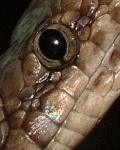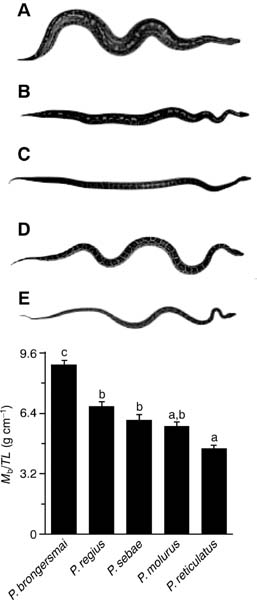» Site Navigation

2 members and 1,541 guests
Most users ever online was 47,180, 07-16-2025 at 05:30 PM.
» Today's Birthdays

» Stats

Members: 75,937
Threads: 249,129
Posts: 2,572,290
Top Poster: JLC (31,651)
|
-
Registered User

can you explain the difference?
I ask this question for my own sheer curiosity: what are the main differences (ie. length/weight/enclosure needs/attitudes/anything else) between a Burmese Python and a Reticulated python? A lot of what I read on other web pages seems misleading, so I thought I would ask the pro's. I'm not looking for a 20 page essay, just curious of how to tell the difference by looking at them and whatever other nifty facts you can think of. Thanks.
2.0 Normal BPs (The Admiral, Ray Mysterio Jr. )
1.0 Normal Cornsnake (Jellybean)
-
-
Re: can you explain the difference?
 Originally Posted by carmich132
I ask this question for my own sheer curiosity: what are the main differences (ie. length/weight/enclosure needs/attitudes/anything else) between a Burmese Python and a Reticulated python? A lot of what I read on other web pages seems misleading, so I thought I would ask the pro's. I'm not looking for a 20 page essay, just curious of how to tell the difference by looking at them and whatever other nifty facts you can think of. Thanks.
Retic BIG!! Burm BIG but not retic BIG.
Retic - 25 - 33 ft long; 200-300 lbs, houseing: small shed like 50-100 sqr feet.
Burm 12 - 25 ft long; 100-250 lbs, housing same as a retic depending on size.
As with any snake you can get some with spunk and the some that are like dogs.
Make up your mind now if you get a spunky one will you be willing to deal with a 45lb snake having a go at you every chance it can??
To tell the difference the word reticulated means like a net (their pattern) anything can be reticulated. The retic has a dimond or net like pattern and the burm doesn't..
The main 2 things here is to remember that; 1: when its getts big you can't get rid of it and 2: this is a snake that when grow will take 4 to 10 people to deal with.
Hope this helps
When you've got 10,000 people trying to do the same thing, why would you want to be number 10,001? ~ Mark Cuban "for the discerning collector"
-
-
Registered User


Re: can you explain the difference?
retics have a lot of silver and yellow... they have orange or silver eyes too. burms dont...
-
-
BPnet Veteran


Re: can you explain the difference?
 Originally Posted by Freakie_frog
Retic BIG!! Burm BIG but not retic BIG.
Retic - 25 - 33 ft long; 200-300 lbs, houseing: small shed like 50-100 sqr feet.
Burm 12 - 25 ft long; 100-250 lbs, housing same as a retic depending on size.
As with any snake you can get some with spunk and the some that are like dogs.
Make up your mind now if you get a spunky one will you be willing to deal with a 45lb snake having a go at you every chance it can??
To tell the difference the word reticulated means like a net (their pattern) anything can be reticulated. The retic has a dimond or net like pattern and the burm doesn't..
The main 2 things here is to remember that; 1: when its getts big you can't get rid of it and 2: this is a snake that when grow will take 4 to 10 people to deal with.
Hope this helps
lets be a little more realistic about those sizes.... burms 10- 16 on average
retics about 14-19 on average. they all can get much larger. think of a retic as a corn snake and a burm as a bp. retics are much faster.
ps-dr satan thats what i was gonna say!
jeff
steve,
the man that started it all 5 years ago. thank you for getting me into the wonderful world of herpetoligy.
you are and will always will be my idol.
-
-
Registered User


Re: can you explain the difference?
glad you pointed out the size thing... i didnt even see that. lol!
 Originally Posted by uro1001
lets be a little more realistic about those sizes.... burms 10- 16 on average
retics about 14-19 on average. they all can get much larger. think of a retic as a corn snake and a burm as a bp. retics are much faster.
ps-dr satan thats what i was gonna say! 
-
-
Re: can you explain the difference?
 Originally Posted by uro1001
retics about 14-19 on average. they all can get much larger. think of a retic as a corn snake and a burm as a bp. retics are much faster.
This is true. I was giving the max size so the person would understand what they have the possiablity of getting it to. Burms are heavier bodied snakes and retic's are leaner snakes.
Very good points.
When you've got 10,000 people trying to do the same thing, why would you want to be number 10,001? ~ Mark Cuban "for the discerning collector"
-
-
Re: can you explain the difference?
Is their max size an issue of conservative feeding practices?
-
-
Registered User


Re: can you explain the difference?
 Originally Posted by Rapture
Is their max size an issue of conservative feeding practices?
growth and reproduction are a function of food intake... this adaptation is one of the things that has made reptiles so successful, and why they have spread out to fill all sorts of niches.
you can limit food intake for large boids, and they will trade off growth so they can reproduce, while still being in very good physical shape.
-
-
Re: can you explain the difference?
 Originally Posted by carmich132
I ask this question for my own sheer curiosity: what are the main differences (ie. length/weight/enclosure needs/attitudes/anything else) between a Burmese Python and a Reticulated python? A lot of what I read on other web pages seems misleading, so I thought I would ask the pro's. I'm not looking for a 20 page essay, just curious of how to tell the difference by looking at them and whatever other nifty facts you can think of. Thanks.

This figure from Ott, B. D. et al. J Exp Biol 2007;210:340-356
may help you see the difference.
The top shows the girth of 5 species of pythons on the same relative scale lengthwise. Photograhs [A] is P.brongersmai (the blood python) [B] P.regius (the royal or ball python) [C] is P. sebae (Anyone know the common name for this one?) [D] P.molurus (the Burmese python) (E) P. reticulatus (Retics or Reticulated Pythons).
The Bar Graph gives you an idea of the relative body shape for each species by displaying the body mass to length ratio (body mass, Mb/total length, TL).
"Note the significant variation in body shape from the short
and stout P. brongersmai to the long and slender P. reticulatus."
The species on the right of the graph still weigh more, but you see that they are relatively skinny for their length.
Note you can ignore the letters at the top of each bar for the purpose of this comparison.
~ 1.0.0 Python regius ~ Wild-type ~
~ 1.0.0 Canis familiaris ~ Blue Italian Greyhound ~
~ 0.0.9 Danio rerio~ Wild-type and Glofish


-
-
Registered User


Re: can you explain the difference?
its good to see brian got his papers published.
-
 Posting Permissions
Posting Permissions
- You may not post new threads
- You may not post replies
- You may not post attachments
- You may not edit your posts
-
Forum Rules
|








 Reply With Quote
Reply With Quote




